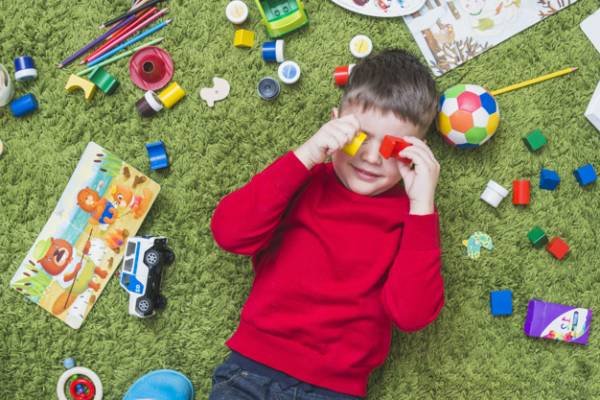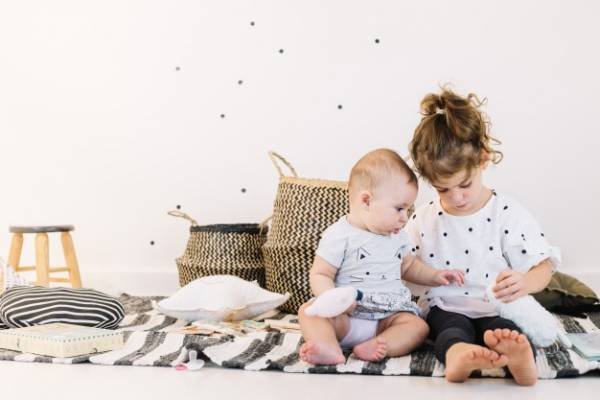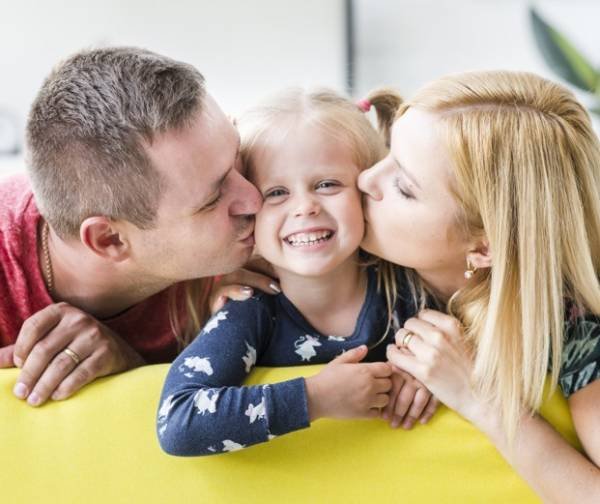Growth and development of three to four-year-olds and useful tips.Interacting with children.At this age.
By the age of three, children can express their feelings more easily with words, learn to control their emotions like anger and fear, become less dependent on others, and learn to do things independently.
They transition from toddlerhood to childhood. They may have many fears, enjoy playing, and take pleasure in physical activities. Gradually, they start spending time away from their usual caregivers.
Sometimes they may feel shy when trying to do new things. Every child at this age grows differently and may develop at varying rates.
If you are concerned about your child’s progress or if they can’t do things even for a short period, it is important to consult a doctor.
Getting help early if there is a problem is essential to prevent it from getting worse. Otherwise, it’s good to know that your child is usually developing in their unique and special way.

Proper behavior.Interacting with three to four-year-olds.
Social and emotional development:
Your three-year-old is beginning to learn how to interact with others. They can manage their strong emotions better than at two, start understanding social skills like sharing and kindness, but can only practice these skills briefly, especially when they feel safe and happy, at other times they may forget.
Your three-year-old often enjoys being with other children and playing. They learn that others have feelings, which means that if others are sad, they can feel sad too.
Sharing and forgiving are skills that they learn around age four. However, if upset or worried, they may find it hard to share. At this age, they learn to wait briefly for things they want, such as “Wait until after lunch to go outside.”
A three-year-old may hit or yell at other kids when trying to please you. With your help, they might be able to try something different or wait a few minutes.
They still have fears of loud noises, darkness, animals, and monsters. Three-year-olds enjoy humor and tend to laugh and repeat childish words or situations.
In this important section.SelMagzAs mentioned in SelMagz, they like to have choices. However, usually having limited choices can help, such as “You can wear your red shoes or your blue shoes.”
When tired or away from home, they might need a favorite blanket or another cozy spot. Three-year-olds can have strong ideas about being a “boy” or “girl,” believing girls wear pretty clothes while boys are like superheroes. They take on responsibilities but might have accidents, such as wetting themselves at night.
Abilities and behavior witha three-year-old child:
Now you can understand that their mind is separate from their parents, and they cannot read it. They still don’t grasp concepts like height and size; they may believe a tall, slim glass has more water than a short glass, leading to misunderstandings.
- Some begin to grasp the concept of time, understanding that night comes after day.
- They understand meanings of tall, short, big, and small.
- They can identify themselves as a boy or a girl and can tell if other kids are boys or girls, but they don’t understand that sex is permanent and won’t change.
- They can say how old they are.

Keys to interacting with three-year-olds.
Abilities and behavior witha four-year-old child:
They might be able to draw a person, likely with a big round head, eyes, and maybe a mouth, along with a straight line for a body and legs. They can copy a square and build a bridge with three blocks.
Physical growth:
At this age, your child will enjoy physical activities like running, jumping, dancing, riding a tricycle, and swinging. They may struggle with walking well, and if they lack calming activities after energetic ones, they might get tired or feel down.
It’s important that they can do these activities confidently and under supervision. At three and a half, they may suddenly lose coordination andself-confidence.They love splashing and playing with water. Some three-year-olds may be scared of pools or the sea, while others enjoy swimming with an adult. (Always supervise children near water.)
- As their balance improves, they can walk along a beam.
- They can use the pedals of a tricycle.
- They can roll a ball, but catching it is still quite hard.
- They can throw a ball using their shoulders and elbows.
- By age four, they can hold a pencil correctly.
- They can dress themselves.
- Between ages three and four, they will learn to use scissors.
- Using the toilet:
Some children will be ready for toilet training at the start of their third year, while others may not be. If your child is naturally a perfectionist or picky about doing things correctly, they may take longer to gain confidence in managing themselves.
Language:
At three, they speak in simple sentences and often have many thoughts in their head that seem hard to express quickly.
When they try to express themselves,
they may stutter.It can be frustrating to listen and explain everything to them, but it is exciting to engage in their imagination. They love being read to and may want a story read to them repeatedly.They can express what they want in most situations. Some three-year-olds speak clearly, while others still use “baby talk.”
They might stumble over some words, but likely will overcome this during the year. An average three-year-old understands 1000 or more words.
They can usually understand words like beside, behind, and above. They ask questions with “what,” “who,” “where,” and “why.” They can talk about what happened yesterday and today. You can build on what your three-year-old tells you.
Do not correct their stutters with words but respond positively with the correct word. Try to be patient. Ask them questions. Some children get so enthusiastic that asking “what?” can be annoying to parents. Usually, they will respond to your request, at least for a few minutes of quiet time for questions.
The child’s stuttering at four years old.

Childcare and preschool:
You may use childcare this year or may have used it before. You likely choose a preschool and plan for your child to start.
You may not have many options, but if you do, you can choose either home or center care, whichever is more suitable and accessible for you.
As noted in SelMagz, it’s very important that if you have any options, you feel satisfied with the caregivers and feel comfortable discussing with them, ensuring your child is happy and comfortable.
The way you and your child react to separation will vary greatly based on personality and life experiences, but childcare and preschool should feel like positive experiences for both you and your child after an initial adjustment period. If not, discuss your concerns with a doctor.
What to watch for:
If you see any of these, talk to a doctor or a childcare nurse:
They often seem unable to understand.
- They do not use three-word sentences or more.
- They do not or fear using the toilet.
- They have a huge fear that lasts a long time.
- They cannot jump with both feet in one place.
- They seem not to understand what you tell them.
- If you are worried, talk to your child’s doctor or nurse.
What you can do:
Give them plenty of physical freedom, such as riding a tricycle, playing with a ball, or learning to swim. Let them do things they can. Provide plenty of warnings before they have to finish all their activities, put away toys, or get ready to leave the house. Provide simple turn-taking games and structured play to help them learn how to play together.
Your three or four-year-old will enjoy rhythm, and you can encourage this by providing music, songs, and rhymes, allowing them to clap or sing simple songs with you.
They love to color; provide large sheets of paper or paints for them. Tell a story for them to illustrate. Provide picture books and storybooks they can follow along and ask them questions about the images.
They may enjoy age-appropriate television programs or videos that are not too fast and can be repeated many times. Provide plenty of love, fun, approval, and encouragement, and begin setting limits that you can prepare to uphold.
Correct behavior and

parentingfor three to four-year-olds.Interacting with three to four-year-olds in daily activities.
To help your child learn and entertain them, you don’t have to play all the time; you can encourage them to help with household tasks, which boosts their sense of responsibility.
Talk to your child about what you want them to do, how to do it, and why it’s important for the family. Doing household chores helps children learn new words, how to listen, and counting, while coordinating their body parts.
Art projects:
Children are naturally interested in art and have an artistic nature. Art projects spark their creativity. Artistic activities help improve their hand-eye coordination, which aids in writing skills.
Child psychology experts at SelMagz recommend providing various papers and writing tools like colored pencils and crayons for your child to draw and paint creatively, without needing a specific model.
Never tell your child what to draw or what colors to use. Ask them about the pictures they’ve drawn and let them talk about what they’ve created. Show what your child has drawn to others; encourage them in front of an audience.
Spread several newspapers or large pieces of plastic on the table or floor and lay paper over it so your child can paint on it. Provide different objects like yarn for them to glue to the paper and make creations. Let your child feel different textures and discuss them.
Poetry and stories:
While playing with your child, read them nursery rhymes and clap and jump along to the songs. Pause before reaching a rhyming word and ask your child to say it.
When they do, praise them. Rhymes and songs are very important for children’s skill development. Hearing and saying rhymes helps them recognize letter sounds and enjoy the music of words.
Mathematics:
Learning to count, measure, and use their hands are good methods for children. Teach them number concepts in daily activities; for example, say to your child, “Let’s divide the dough into two parts,” or “Let’s see how many plates we need for the table: one for mom, one for dad, and one for you—great, that’s three!”
To teach about length and height, say that this ribbon is too short to wrap around dad’s gift. Regarding weight, tell your child their weight and express that they’ve gotten heavier, and you can’t lift them. Count your child’s favorite toys to practice counting.
While playing with your three-year-old, integrate math education by sorting toys according to shape or color. Using blocks, you can help your child understand height, length, and width. Through a game like tossing balls into a basket and counting the balls inside, you can teach your child counting.
Important tips for interacting with three and four-year-olds:
Pay attention to your child and provide encouragement.
- Set aside time to play and engage in enjoyable activities with your child.
- Express positive feelings about them so they know they are good children.
- Teach your child to respect others and use polite words like please and thank you.
- Encourage them to find ways to resolve conflicts with others.
- Explain to them that if during anger they hit a friend who took their toy without permission, the friend might go home, and they can’t play together anymore, so they should find another way to get their toy back.
- Teach them to care for others through actions like feeding birds or helping neighbors.Hug, cuddle, and kiss your child.Tell your child that you love them.
- Be creative and use every opportunity to teach and show love to your child.
- Interacting with children.
- Growth of three to four-year-old children.
- Abilities of three-year-old children.







